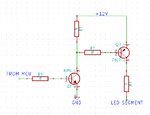asking
Full Member level 5
Hello,
Transistor or Mosfet to be used with 7 Segment Multiplexing ? i want to multiplex 2.3" 4 7-segment Displays.... ? which would be the faster in real time so there's no lag in display....?
Transistor or Mosfet to be used with 7 Segment Multiplexing ? i want to multiplex 2.3" 4 7-segment Displays.... ? which would be the faster in real time so there's no lag in display....?



